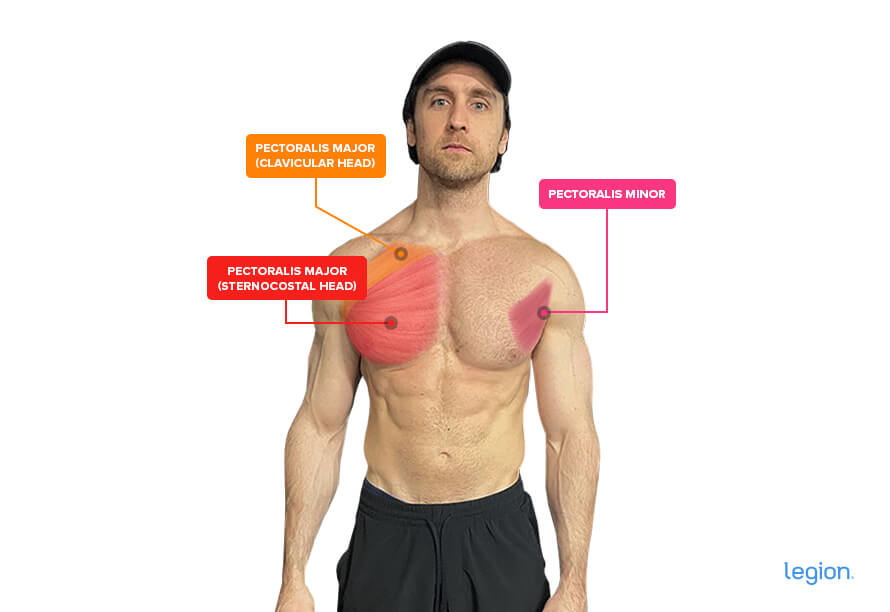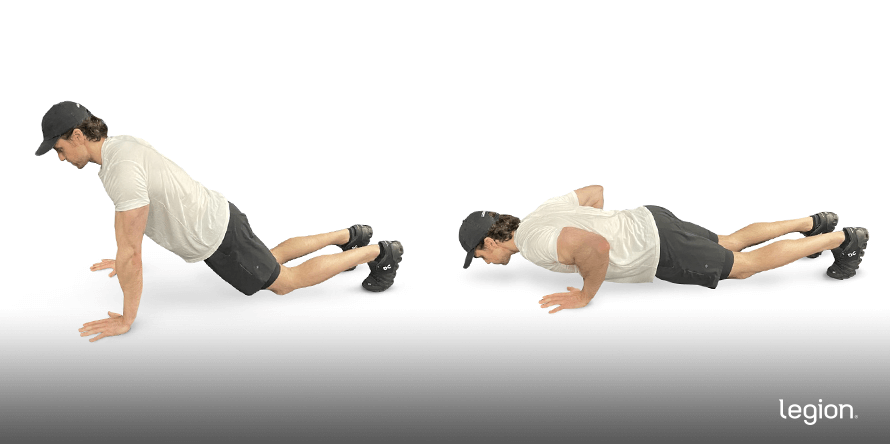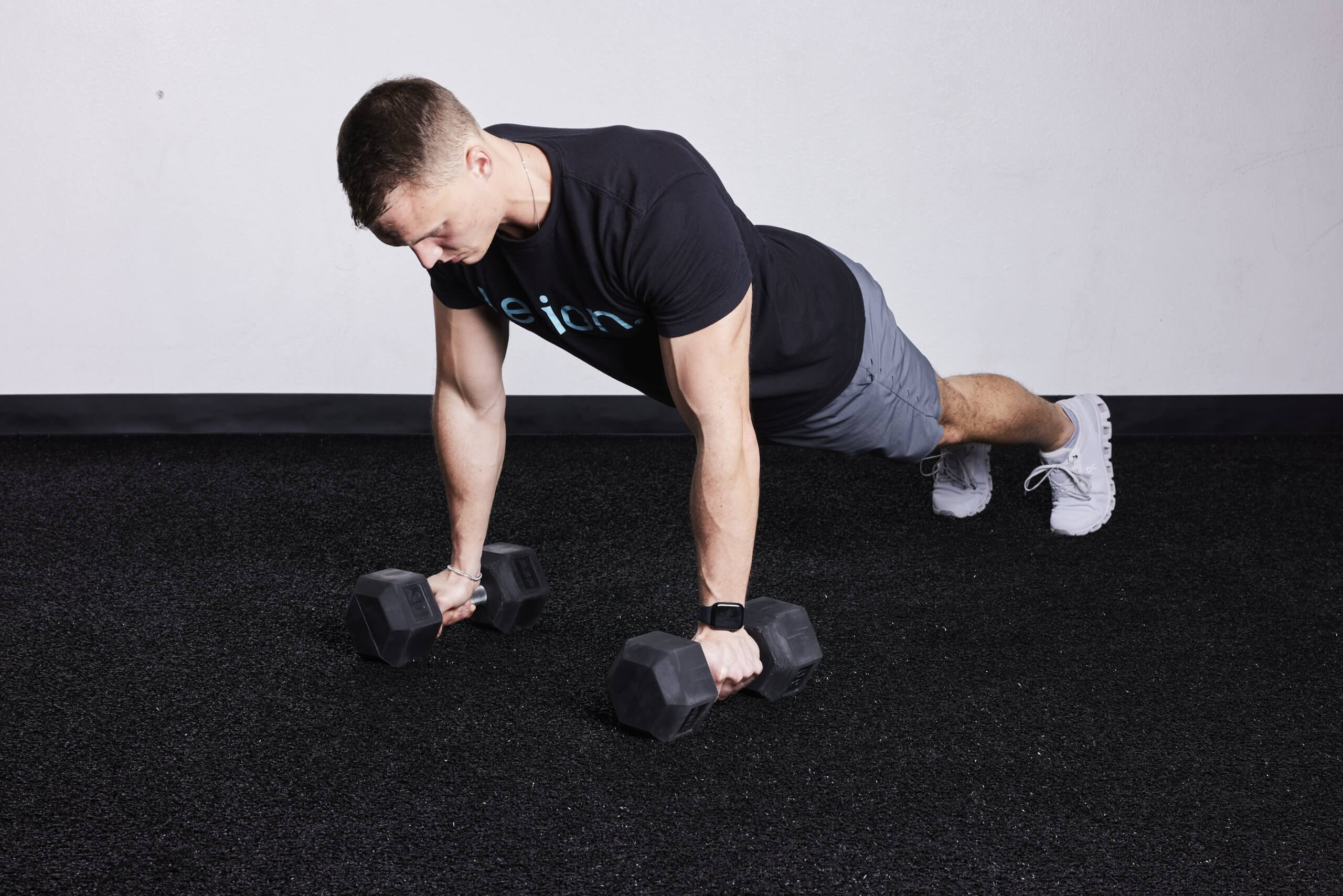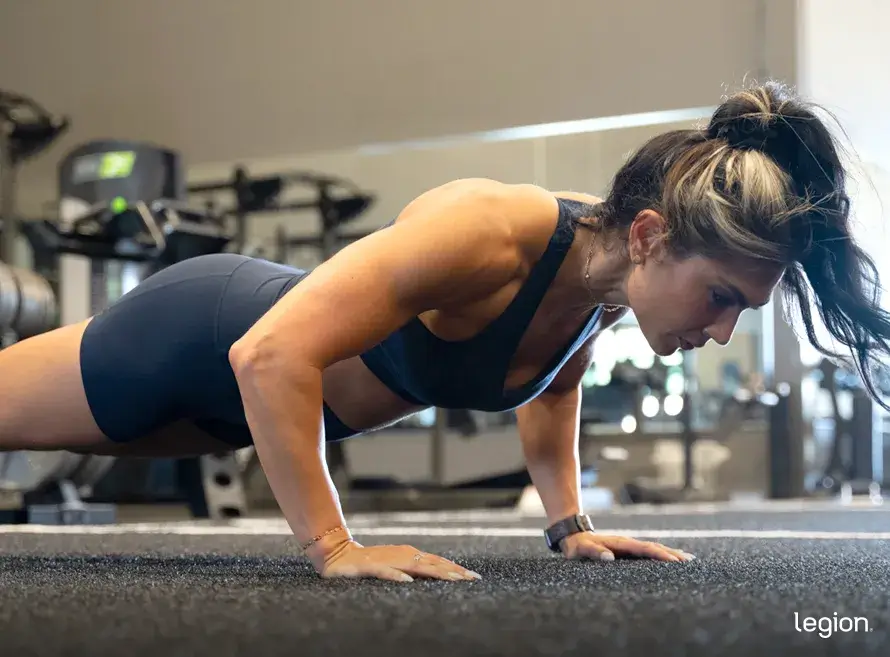Most gymgoers believe bench pressing is the only way to build bigger pecs.
By their logic, chest workouts at home are a compromise—fine if you’re in a bind, but not good enough for making real gains.
They’re wrong.
If you know how to set up an effective at-home chest workout, you can build muscle using nothing but your body weight. Add a resistance band or a pair of dumbbells, and you can make better progress than many gymgoers using barbells and machines.
In this guide, you’ll get everything you need: a full breakdown of chest anatomy, 10 of the best home chest-building exercises, and three complete at-home chest workouts tailored to your strength level.
Want to know exactly how you should train to reach your fitness goals? Take our free 60-second training quiz and find out now.
Key Takeaways
- Chest workouts at home can be just as effective as gym workouts—especially if you do effective exercises, train hard, and use resistance bands and dumbbells when possible.
- To build full, balanced pecs, your chest workouts at home should include exercises that target both the upper and lower portions of your chest.
- The most effective home chest-building exercises include several push-up variations, dips, the floor press, and the banded chest press.
- To get the most out of your at-home chest workouts, train close to failure and track your progress.
- The right supplements can also help. Consider using a high-quality protein powder to help you reach your daily protein target, creatine to support recovery and muscle growth, and a pre-workout to enhance energy, focus, and performance.
Table of Contents
+
Chest Anatomy
The main chest muscle is the pectoralis major, or “pec major.”

As you can see, it has two parts or “heads”:
- The sternocostal head (“lower chest”)
- The clavicular head (“upper chest”)
To build full, balanced pecs, your chest workouts at home should include exercises that target both areas.
Beneath the pec major lies a smaller muscle called the pectoralis minor. Most effective home pectoral exercises train the pec minor indirectly, so you don’t need specific exercises to target it.
Chest Workouts At Home: Exercise List

Creating good chest workouts at home starts with selecting the right exercises. Below, you’ll find the best home chest-building exercises you can do with no equipment, plus a few extras if you’ve got a resistance band or a pair of dumbbells at your disposal.
1. Push-up

Why: When it comes to home pectoral exercises, the classic push-up is hard to beat. It’s simple to learn, requires no equipment, and trains your entire chest. That’s why all of the best chest workouts at home revolve around the push-up and its variations.
How to:
- Get on all fours and place your hands slightly wider than shoulder-width apart.
- Extend your legs behind you so your body forms a straight line from head to heels.
- Lower your chest to the floor by bending your elbows.
- Push your body up and return to the starting position.
Expert Tip: To protect your shoulders, keep your elbows about 4-to-6 inches from your sides throughout the movement.
READ MORE: How to Do the Push-up: Form, Variations, and Workouts
2. Knee Push-up

Why: The knee push-up is one of the best chest exercises at home for beginners. It mimics the full push-up but doesn’t require you to lift as much of your body weight, so it’s ideal for those new to strength training and looking to gain strength safely.
How to:
- Get on all fours and place your hands slightly wider than shoulder-width apart.
- Walk your hands forward and allow your hips to drop until your body forms a straight line from your head to your knees.
- Lower your chest to the floor by bending your elbows.
- Push your body up and return to the starting position.
Expert Tip: Start with your toes on the floor for extra balance. Once you feel stronger, lift your feet so you’re balancing only on your knees to make the exercise more challenging.
3. Feet-Elevated Push-up

Why: The feet-elevated push-up is one of the most effective bodyweight pec exercises for building upper chest size. Just keep in mind it’s more advanced than the regular push-up—elevating your feet shifts more of your body weight onto your hands, making the movement more challenging.
How to:
- Get on all fours with your knees 1-to-2 feet from a stable surface 1-to-2 feet off the floor.
- Position your hands slightly wider than shoulder-width apart, then place your feet on the elevated surface so that your body forms a straight line from your head to your feet.
- Lower your chest to the floor by bending your elbows.
- Push your body up and return to the starting position.
Expert Tip: The higher your feet, the harder the exercise. Start with a low step and work up to a higher surface as you get stronger.
4. Diamond Push-up

Why: The diamond push-up is a great chest exercise with no equipment because it challenges your pecs through a different range of motion than regular push-ups, which is important for overall development. It also emphasizes the triceps, making it useful for gaining all-around upper-body size and strength.
How to:
- Get on all fours and place your hands close together so your thumbs and index fingers form a diamond shape beneath your chest.
- Extend your legs behind you so your body forms a straight line from your head to your feet.
- Lower your chest to the floor by bending your elbows.
- Push your body up and return to the starting position.
Expert Tip: If you struggle with depth or wrist discomfort, widen your hands slightly until you find a position that feels comfortable and stable.
5. Pike Push-up

Why: Like the feet-elevated push-up, the pike push-up is a pec exercise you can do at home that emphasizes the upper portion of your chest. However, because you don’t have to support as much of your body weight, it’s slightly more suitable for beginners.
How to:
- Get on all fours and place your hands slightly wider than shoulder-width apart.
- Walk your hands backward a few inches, then raise your hips so your body forms an upside-down “V” shape, with your biceps next to your ears and your legs straight.
- Lower the top of your head toward the floor by bending your elbows.
- Push your body up and return to the starting position.
Expert Tip: The closer your hands and feet are together, the harder the exercise becomes, so adjust your stance to find an appropriate level of difficulty.
6. Deficit Push-up

Why: The deficit push-up allows you to train your chest through a larger range of motion and when more deeply stretched, which likely benefits muscle growth. It’s one of the best home chest-building exercises if you’re already comfortable with standard push-ups and want to make them more challenging without adding weight.
How to:
- Get on all fours and place your hands on two sturdy, elevated surfaces (e.g., yoga blocks, weight plates, or books) slightly wider than shoulder-width apart.
- Extend your legs behind you so your body forms a straight line from your head to your feet.
- Lower your chest between your hands by bending your elbows.
- Push your body up and return to the starting position.
Expert Tip: You only need to raise your hands 2-to-3 inches off the floor. Any higher and the exercise becomes easier, reducing its muscle- and strength-building potential.
7. Banded Push-up

Why: Using a resistance band is one of the easiest ways to make your chest workouts at home more challenging once exercises without equipment become too easy. That’s important because you must increase the difficulty of your training over time to continue gaining muscle and strength.
How to:
- Loop a resistance band across your upper back and hold one end in each hand.
- Get on all fours and place your hands slightly wider than shoulder-width apart, securing the band under your palms.
- Extend your legs behind you so your body forms a straight line from your head to your feet.
- Lower your chest to the floor by bending your elbows.
- Push your body up against the band’s resistance and return to the starting position.
Expert Tip: As you get stronger, you can progress by switching to a thicker band or performing the banded push-up with a deficit or with your feet elevated.
RELATED: The Definitive Guide to Resistance Band Workouts
8. Banded Chest Press

Why: The banded chest press is a solid chest exercise at home because it mimics the movement of a dumbbell or machine chest press. It trains your pecs through a full range of motion and provides constant tension, which is important for gaining muscle.
How to:
- Anchor a resistance band behind you at chest height—use a door anchor or loop it around a sturdy object.
- Hold one end of the band in each hand and step forward until you feel tension.
- Stagger your stance and raise your hands to chest level with your elbows bent.
- Press the bands straight in front of you until your arms are extended.
- Slowly return to the starting position.
Expert Tip: If the exercise feels too easy, step farther away from the anchor point to increase the tension or use a thicker band.
9. Floor Press

Why: While chest workouts with no equipment can be effective, including some dumbbell exercises can help you keep progressing (and making gains!). The dumbbell floor press requires minimal equipment, making it perfect if you’ve just got a pair of dumbbells at home.
How to:
- While sitting on the floor, hold a dumbbell in each hand and rest them on your thighs.
- Lie back and position the dumbbells on either side of your chest, with your triceps resting on the floor.
- With your palms facing your feet, press the dumbbells straight over your chest until your arms are straight.
- Reverse the movement and return to the starting position.
Expert Tip: Before your first rep, pull your shoulder blades together and down toward your butt—and keep them there for the entire set. This puts your shoulders in a strong, stable position for pressing.
10. Dip

Why: The dip is a top-tier chest exercise, but many overlook it in their pec training at home because they think it requires special equipment. While dip bars are ideal, you can also do dips using the backs of sturdy chairs, the corner of a railing, or any setup where you can support your body weight on your arms and lower your body between your hands.
How to:
- Grab the bars, chairs, or railing and press through your arms to lift your body so your arms are straight and supporting your weight.
- Lean slightly forward, bend your knees to keep your feet off the floor, and lower your body by bending your elbows until your upper arms are roughly parallel to the ground.
- Press through your hands to drive yourself back up to the starting position.
Expert Tip: If you keep your torso too upright, you’ll shift the emphasis to your triceps. Maintain a slight forward lean throughout each rep to keep the focus on your chest.
READ MORE: The Ultimate Guide to Chest Dips for Building Your Chest
The Best Chest Workouts at Home for Size and Strength

Now that you know the best home chest-building exercises, let’s look at how to turn them into effective workouts.
Below are three at-home chest workouts:
- One for beginners
- One for those familiar with at-home training
- One for those looking for a challenging at-home chest workout
Pick the workout that matches your current strength level and do it twice per week on non-consecutive days (Mondays and Thursdays, for example). Stick with it until you can complete all the sets and reps comfortably, then move on to the next level.
Once you’ve mastered all three, you’ll have built a stronger, more muscular chest. To continue progressing beyond that point, you’ll likely have to add free-weight training to your routine.
At-Home Chest Workout #1
- Push-up: 4 sets | 10-to-20 reps | 2-to-3 min rest
- Knee Push-up: 4 sets | 10-to-20 reps | 2-to-3 min rest
At-Home Chest Workout #2
- Feet-Elevated Push-up: 3 sets | 10-to-20 reps | 2-to-3 min rest
- Deficit Push-up: 3 sets | 10-to-20 reps | 2-to-3 min rest
- Diamond Push-up: 3 sets | 10-to-20 reps | 2-to-3 min rest
At-Home Chest Workout #3
- Dip: 3 sets | 10-to-20 reps | 2-to-3 min rest
- Feet-Elevated Push-up: 3 sets | 10-to-20 reps | 2-to-3 min rest
- Banded Push-up: 3 sets | 10-to-20 reps | 2-to-3 min rest
3 Tips for Better Chest Workouts at Home

Maximize your at-home chest workout results with these three simple tips.
1. End every set 1-to-2 reps shy of muscle failure.
As I explain in my fitness books for men and women, to maximize your results, you must take most of the sets in your at-home chest workouts to within a rep or two of failure.
Ask yourself at the end of each set, “If I had to, how many more reps could I have gotten with good form?” If the answer is more than two, increase the reps to make your next set more challenging.
READ MORE: Does Training to Failure Help You Build More Muscle? What Science Says
2. Track your workouts.
Tracking your workouts keeps you focused, motivated, and moving forward. If you’re not writing things down, you’re basically guessing your way through every session. And that’s a recipe for spinning your wheels.
To keep it simple, use a notebook or the notes app on your phone. Log each exercise, the rep range, and how many reps you hit per set. For example:
At-Home Chest Workout 05/08/2025
Push-up (10-to-20 reps)
- Set 1: 20 reps
- Set 2: 19 reps
- Set 3: 17 reps
Before each chest workout at home, check your previous numbers and aim to beat them by adding a rep or improving your form. You can also jot down how you felt, if anything hurt, or other notes that might explain your performance. These details help you train smarter over time.
3. Take the right supplements.
These supplements can help you optimize your at-home chest workout performance and gains:
- Protein powder: Protein powder, such as whey or casein, provides your body with the nutrients needed to build muscle tissue and recover from workouts. For a clean and delicious protein powder, try Whey+ or Casein+.
- Creatine: Creatine boosts muscle and strength gain, improves anaerobic endurance, and reduces muscle damage and soreness from your workouts. For a natural source of creatine, try our creatine monohydrate, creatine gummies, or Recharge.
- Pre-workout: A high-quality pre-workout enhances energy, mood, and focus, increases strength and endurance, and reduces fatigue. For a top-tier pre-workout containing clinically effective doses of 6 science-backed ingredients, try Pulse with caffeine or without.
(If you’d like even more specific advice about which supplements you should take to reach your health and fitness goals, take the Legion Supplement Finder Quiz, and in less than a minute, you’ll know exactly what supplements are right for you.
FAQ #1: How effective are chest workouts at home?
Chest workouts at home are more effective than most people realise.
Many gymgoers assume you have to lift heavy weights to build muscle. And while heavy lifting is excellent for gaining size and strength, you can still build muscle with bodyweight chest exercises—so long as you can train close to failure without doing more than about 30 reps per set.
Once bodyweight exercises become too easy, adding simple equipment like resistance bands keeps your at-home chest workouts effective. In fact, research shows that for most people, resistance band training is enough to gain muscle and strength.
I’m a prime example of how effective home chest exercises can be. I used the same kinds of at-home chest workouts you’ve learned in this article to easily maintain my muscle mass when my gym was closed for several months in early 2020.
Here’s a pic of me in late 2019 before the Covid lockdowns (left) and one of me after several months of chest workouts at home:

Not too different, I’m sure you’ll agree.
FAQ #2: What’s the best workout at home for chest?
The best home chest workout depends on your experience level. In this article, you’ll find three options:
- One for absolute beginners
- One for those familiar with at-home training
- One for those looking for a challenging at-home chest workout
Pick the one that suits your current strength level, follow it consistently, and move to the next level once it gets too easy. That way, you’ll keep progressing without needing a full gym setup.
FAQ #3: What’s the best equipment for chest workouts at home?
The best way to maintain or gain strength and muscle with at-home chest workouts is to invest in a few pieces of equipment that allow you to more effectively implement progressive overload.
Here are the best ones:
- Push-up Handles: These increase your range of motion, which likely boosts muscle growth, and they reduce wrist strain—especially helpful if you’re doing pec workouts at home for more than a few weeks
- Resistance Bands: Resistance bands make chest workouts at home effective for longer by enabling you to add resistance to exercises like push-ups and chest presses.
- Dumbbells or Kettlebells: A pair of adjustable dumbbells or a few kettlebells opens the door to more challenging and varied at-home chest workouts.
- Adjustable Bench: This lets you do a wider range of dumbbell or kettlebell exercises with better form and a longer range of motion.
- Dip Stand: A dip stand makes performing dips easier and safer. If you also get a dip belt, you can progressively add weight as you get stronger.
Scientific References +
- Trebs, Arthur A, et al. “An Electromyography Analysis of 3 Muscles Surrounding the Shoulder Joint during the Performance of a Chest Press Exercise at Several Angles.” Journal of Strength and Conditioning Research, vol. 24, no. 7, July 2010, pp. 1925–1930, insights.ovid.com/strength-conditioning-research/jscr/2010/07/000/electromyography-analysis-muscles-surrounding/31/00124278, https://doi.org/10.1519/jsc.0b013e3181ddfae7.
- Costa, Bruna Daniella de Vasconcelos, et al. “Does Performing Different Resistance Exercises for the Same Muscle Group Induce Non-Homogeneous Hypertrophy?” International Journal of Sports Medicine, vol. 42, no. 09, 13 Jan. 2021, pp. 803–811, https://doi.org/10.1055/a-1308-3674.
- Kim, You-Sin, et al. “Effect of the Push-up Exercise at Different Palmar Width on Muscle Activities.” Journal of Physical Therapy Science, vol. 28, no. 2, 2016, pp. 446–449, https://doi.org/10.1589/jpts.28.446.
- Hartmann, Hagen, et al. “Influence of Squatting Depth on Jumping Performance.” Journal of Strength and Conditioning Research, vol. 26, no. 12, Dec. 2012, pp. 3243–3261, https://doi.org/10.1519/jsc.0b013e31824ede62.
- Pinto, Ronei S, et al. “Effect of Range of Motion on Muscle Strength and Thickness.” Journal of Strength and Conditioning Research, vol. 26, no. 8, 2012, pp. 2140–5, www.ncbi.nlm.nih.gov/pubmed/22027847, https://doi.org/10.1519/JSC.0b013e31823a3b15.
- Stokes, Tanner, et al. “Recent Perspectives Regarding the Role of Dietary Protein for the Promotion of Muscle Hypertrophy with Resistance Exercise Training.” Nutrients, vol. 10, no. 2, 7 Feb. 2018, p. 180, www.mdpi.com/2072-6643/10/2/180/pdf.
- Eckerson, Joan M., et al. “Effect of Creatine Phosphate Supplementation on Anaerobic Working Capacity and Body Weight after Two and Six Days of Loading in Men and Women.” The Journal of Strength and Conditioning Research, vol. 19, no. 4, 2005, p. 756, https://doi.org/10.1519/r-16924.1.
- Bassit, Reinaldo Abunasser, et al. “Effect of Short-Term Creatine Supplementation on Markers of Skeletal Muscle Damage after Strenuous Contractile Activity.” European Journal of Applied Physiology, vol. 108, no. 5, 3 Dec. 2009, pp. 945–955, https://doi.org/10.1007/s00421-009-1305-1.
- Schoenfeld, Brad J., et al. “Loading Recommendations for Muscle Strength, Hypertrophy, and Local Endurance: A Re-Examination of the Repetition Continuum.” Sports, vol. 9, no. 2, 22 Feb. 2021, p. 32, pmc.ncbi.nlm.nih.gov/articles/PMC7927075/, https://doi.org/10.3390/sports9020032.
- Baz-Valle, Eneko, et al. “Total Number of Sets as a Training Volume Quantification Method for Muscle Hypertrophy.” Journal of Strength and Conditioning Research, vol. Publish Ahead of Print, no. 3, 30 July 2018, https://doi.org/10.1519/jsc.0000000000002776.
- Schoenfeld, Brad J., et al. “Effects of Low- vs. High-Load Resistance Training on Muscle Strength and Hypertrophy in Well-Trained Men.” Journal of Strength and Conditioning Research, vol. 29, no. 10, Oct. 2015, pp. 2954–2963, pubmed.ncbi.nlm.nih.gov/25853914/, https://doi.org/10.1519/jsc.0000000000000958.
- Calatayud, Joaquin, et al. “Bench Press and Push-up at Comparable Levels of Muscle Activity Results in Similar Strength Gains.” Journal of Strength and Conditioning Research, vol. 29, no. 1, Jan. 2015, pp. 246–253, https://doi.org/10.1519/jsc.0000000000000589.
- Hartmann, Hagen, et al. “Influence of Squatting Depth on Jumping Performance.” Journal of Strength and Conditioning Research, vol. 26, no. 12, Dec. 2012, pp. 3243–3261, https://doi.org/10.1519/jsc.0b013e31824ede62. Accessed 1 Nov. 2019.










